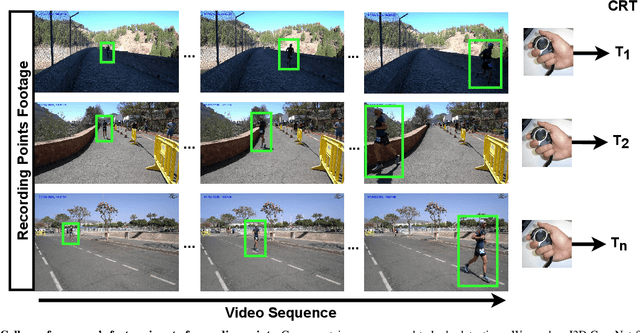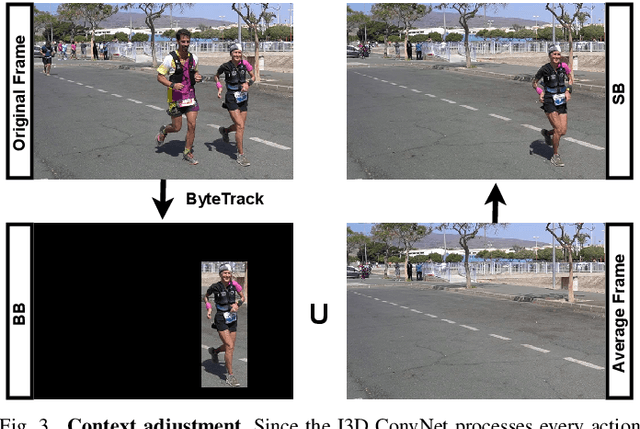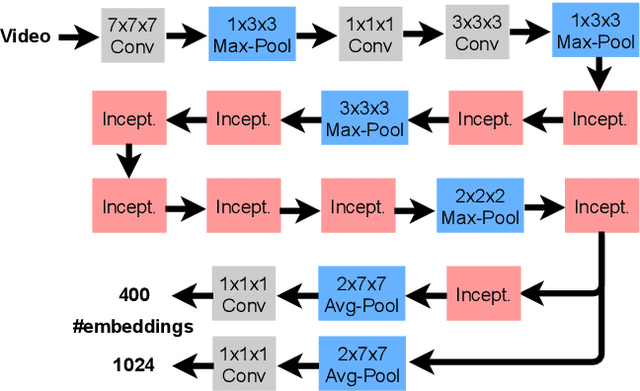Daniel Hernández-Sosa
A Large-Scale Re-identification Analysis in Sporting Scenarios: the Betrayal of Reaching a Critical Point
Dec 29, 2023Abstract:Re-identifying participants in ultra-distance running competitions can be daunting due to the extensive distances and constantly changing terrain. To overcome these challenges, computer vision techniques have been developed to analyze runners' faces, numbers on their bibs, and clothing. However, our study presents a novel gait-based approach for runners' re-identification (re-ID) by leveraging various pre-trained human action recognition (HAR) models and loss functions. Our results show that this approach provides promising results for re-identifying runners in ultra-distance competitions. Furthermore, we investigate the significance of distinct human body movements when athletes are approaching their endurance limits and their potential impact on re-ID accuracy. Our study examines how the recognition of a runner's gait is affected by a competition's critical point (CP), defined as a moment of severe fatigue and the point where the finish line comes into view, just a few kilometers away from this location. We aim to determine how this CP can improve the accuracy of athlete re-ID. Our experimental results demonstrate that gait recognition can be significantly enhanced (up to a 9% increase in mAP) as athletes approach this point. This highlights the potential of utilizing gait recognition in real-world scenarios, such as ultra-distance competitions or long-duration surveillance tasks.
Classifying Soccer Ball-on-Goal Position Through Kicker Shooting Action
Dec 23, 2023Abstract:This research addresses whether the ball's direction after a soccer free-kick can be accurately predicted solely by observing the shooter's kicking technique. To investigate this, we meticulously curated a dataset of soccer players executing free kicks and conducted manual temporal segmentation to identify the moment of the kick precisely. Our approach involves utilizing neural networks to develop a model that integrates Human Action Recognition (HAR) embeddings with contextual information, predicting the ball-on-goal position (BoGP) based on two temporal states: the kicker's run-up and the instant of the kick. The study encompasses a performance evaluation for eleven distinct HAR backbones, shedding light on their effectiveness in BoGP estimation during free-kick situations. An extra tabular metadata input is introduced, leading to an interesting model enhancement without introducing bias. The promising results reveal 69.1% accuracy when considering two primary BoGP classes: right and left. This underscores the model's proficiency in predicting the ball's destination towards the goal with high accuracy, offering promising implications for understanding free-kick dynamics in soccer.
An X3D Neural Network Analysis for Runner's Performance Assessment in a Wild Sporting Environment
Jul 22, 2023Abstract:We present a transfer learning analysis on a sporting environment of the expanded 3D (X3D) neural networks. Inspired by action quality assessment methods in the literature, our method uses an action recognition network to estimate athletes' cumulative race time (CRT) during an ultra-distance competition. We evaluate the performance considering the X3D, a family of action recognition networks that expand a small 2D image classification architecture along multiple network axes, including space, time, width, and depth. We demonstrate that the resulting neural network can provide remarkable performance for short input footage, with a mean absolute error of 12 minutes and a half when estimating the CRT for runners who have been active from 8 to 20 hours. Our most significant discovery is that X3D achieves state-of-the-art performance while requiring almost seven times less memory to achieve better precision than previous work.
Towards cumulative race time regression in sports: I3D ConvNet transfer learning in ultra-distance running events
Aug 23, 2022



Abstract:Predicting an athlete's performance based on short footage is highly challenging. Performance prediction requires high domain knowledge and enough evidence to infer an appropriate quality assessment. Sports pundits can often infer this kind of information in real-time. In this paper, we propose regressing an ultra-distance runner cumulative race time (CRT), i.e., the time the runner has been in action since the race start, by using only a few seconds of footage as input. We modified the I3D ConvNet backbone slightly and trained a newly added regressor for that purpose. We use appropriate pre-processing of the visual input to enable transfer learning from a specific runner. We show that the resulting neural network can provide a remarkable performance for short input footage: 18 minutes and a half mean absolute error in estimating the CRT for runners who have been in action from 8 to 20 hours. Our methodology has several favorable properties: it does not require a human expert to provide any insight, it can be used at any moment during the race by just observing a runner, and it can inform the race staff about a runner at any given time.
 Add to Chrome
Add to Chrome Add to Firefox
Add to Firefox Add to Edge
Add to Edge